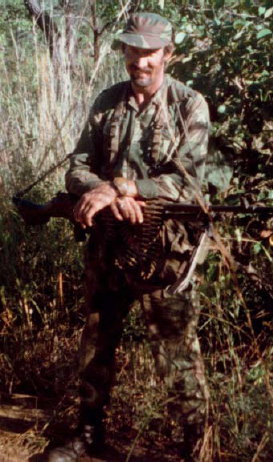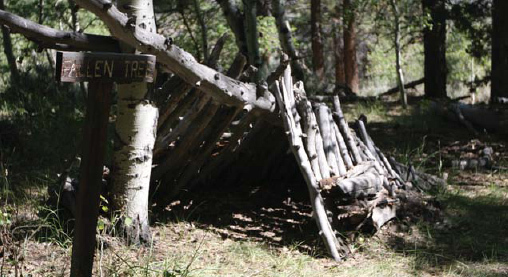Cold
Cold kills as surely as a knife. I have always been a warm-weather soldier: I just don’t like the cold and have always felt that if someone wants some place that is really cold then they can have it. Joking aside, unfortunately, I have had to spend time in places a lot more cold than is pleasant. I know soldiers who have had to cut off their toes to stop frostbite spreading. Keep yourself warm or you will never tap-dance again.
REMEMBER:
It gets very cold, say below -20°, then watch out for touching metal objects. Because metal conducts heat so well it conducts the heat away from your skin and causes the moisture to freeze sticking you to the object be it rifle, vehicle or whatever. I have seen it happen in a German winter and it can be very funny to watch but somewhat inconvenient to experience. Don’t let it happen to you.
If you find yourself in a cold climate then you have an interest in keeping yourself both warm, dry and out of the wind. You should be issued with warm clothing but if, for some reason you are out without the right kit then you can improve your situation by packing the space between your trousers and legs and jacket and body with paper or straw. This will insulate you to some extent. As a note I will say here that you want tight trousers and jackets to look smart on the parade ground and very baggy ones for soldiering in. Baggy clothing both breaks up your visible outline and gives you room to carry gear inside or wear the clothing over bandages and dressings. I often slip empty mags into my jacket front as I take them off the weapon when time is an issue.
Wind
Whatever you do, wear windproof clothing in cold weather. I have worked in Europe where it has been 30° below freezing and often it has felt OK when there has been no wind. But with a wind just a few degrees of frost can feel like Siberia.
Rain
If you get wet and the weather is bad you will be cold and miserable, especially if there is a breeze to carry your heat away. The thing about getting wet on patrol is that you often cannot get dry for days. Your clothing rubs up sores and the skin peels off your feet like you have some terrible disease. This makes life a lot less pleasant and can be avoided to some extent.

See how this gunner blends into the bush background wearing just his Rhodesian uniform. (Author’s Collection)
If possible, when you have got wet, and you are in a safe area or well hidden, take off all your wet clothes and get into your sleeping bag with them. The bag will soak up the moisture from your body and you will soon be warm and dry. Eventually, your body heat will dry out the clothing in the bag with you. Be warned – putting on cold, wet clothing in a cold climate is not for the faint hearted.
The poncho
A long-time favourite of mine has been the ‘poncho’. The name comes from the square of material with a hole in the middle worn with the head through the hole like an all-round cape by the Spanish, the Mexicans and Clint Eastwood.
The sort of poncho I am speaking of is made of a waterproof, camouflaged fabric. It consists of a rectangle of material about 2m square with a hood fixed to the hole in the centre. Worn as intended it keeps the rain off better than almost anything without causing you to get sweaty because the breeze can still get around you. You can wear a pack and carry a rifle ready for use under the poncho and keep these dry too. Then you can use it for a tent, a sunshade, a windbreak or a groundsheet.
Sun
A strong sun is a killer too. Always wear a hat which casts shade on your neck whenever you are out in strong sun. If you get the sun on your neck for a while you will get sunstroke. You will only do it once as it feels awful. You will at best feel dizzy and as sick as a dog. Get it bad and you are out of action for days. This can be fatal if you are out on patrol without support.
Some people prefer a broad brimmed hat and others prefer a ‘kepi’. For the non-French amongst my readers, a kepi is a hat of the style issued to the French Foreign Legion. Its significant feature is the neck flap which hangs down behind like the tail on a ‘Davey Crocket’ hat. Think of a baseball cap with a flap behind to keep the sun off your neck. The broad brimmed hat looks less smart but does keep the sun off your ears.
REMEMBER:
Guys with a lighter skinned European ancestry will burn quicker but no matter the colour of your skin everyone is susceptible to sunburn and heat stroke.
Men who have worked in Africa for a long time tend to cover all their body from the sun. I wear a kind of camouflage overall – coverall in the US – in hot countries as it keeps the sun off and is loose round the wedding tackle to avoid sweat rash.
Heat
When you move to a hot climate from a cold the heat gets you down for a while and you feel tired all the time. There is nothing you can do but put up with it for the couple of months it takes for your body to adjust. Drink plenty and take the salt pills while you are waiting. After you have become acclimatized, and it takes about 4 months to get fully acclimatized, the hottest weather will not bother you.
Notice how Arabs and Africans wear heavy clothing in the hottest weather. This is because they are accustomed to the heat. Temperatures like an oven can feel cool to them. You will get the same providing you stay in the heat and don’t spend all your rest time in air conditioning. The main effects from heat are feeling as though you don’t want to do anything and a true reduction in your physical performance – which is quite different. Make sure you stay alert when it matters – bullets accept no excuses so you need to use that old-fashioned concept of will power.
When I first went to Africa as a youngster I worked out in the sun with my shirt off for a couple of hours. It only felt like a warm day and I have quite dark skin. The next day I was covered in huge blisters everywhere above the waist. I had to complete forced marches in this condition and my shoulders bled from the straps of my pack. I have been very careful of the sun ever since then and I want you to be the same.
Camouflage
The idea of camouflage pattern uniforms is that at a distance you should be invisible. This just doesn’t happen in practice but wearing camo does make you less obvious. To get really invisible you have to add some of the local plant life to your outfit.
Have you noticed that all the different countries involved in Afghanistan all wear different camouflage pattern for the same job? This just confirms my belief that for day-to-day use – where you are not, say, lying up in an observation position or as a sniper – so long as the camo is dull it makes little odds. So wear your national camo and make sure there are no shiny bits showing to catch the sun and draw attention to you.
DIY SHELTERS
Humans are made to operate pretty well in what we consider to be a mild climate without too much sun or rain. As a soldier on patrol the problems you face are too much sun, heat, cold, wind and rain. The places you are going to find the inclement weather are mountains, deserts and forests. Mountains are cold because they are high up. They are always windy for the same reason. Deserts are hot in the day, mostly, and cold at night. Forests tend to be wet – or they wouldn’t grow and they are often cold too. If you are so inclined, you can buy a survival book for the type of area you are posted to and, like the boy scout, be prepared. In case you can’t be bothered here are a few ideas for making yourself comfortable.

Home-made shelter. It is unlikely that you will have the time to make a shelter like this while out on a mission, or that it would stay undiscovered for long if you did. (USMC)